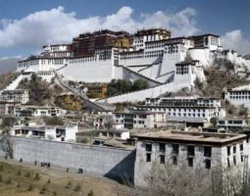Difference between revisions of "Tibet"
(Created page with "thumb|250px| Tibet is a sparsely populated mountainous country with India and Nepal to its south and China to its north and east. Envoys from the Tibetan...") |
|||
| Line 1: | Line 1: | ||
[[File:Tibet.jpg|thumb|250px|]] | [[File:Tibet.jpg|thumb|250px|]] | ||
| − | Tibet is a sparsely populated mountainous country with India and Nepal to its south and China to its north and east. Envoys from the Tibetan king first brought Vajrayāna Buddhism to Tibet from India in the 7th century, but the religion only became firmly established after the 11th century. Since then, nearly all Tibetans have been Buddhists. In 1951 the communist government of China invaded Tibet and, after a revolt against their occupation in 1959, they began a brutal campaign to destroy Buddhism and Tibetan identity. Today, a degree of religious freedom has returned to Tibet and Buddhism there is undergoing something of a reformation. Some half a million Tibetan refugees in India still practise their religion with great devotion. A Buddhist monk, the Dalai Lāma, is both the spiritual and secular leader of the Tibetan people, although he now lives in exile in India. | + | [[Tibet]] is a sparsely populated mountainous country with [[India]] and [[Nepal]] to its [[south]] and [[China]] to its [[north]] and [[east]]. Envoys from the [[Tibetan king]] first brought [[Vajrayāna Buddhism]] to [[Tibet]] from [[India]] in the 7th century, but the [[religion]] only became firmly established after the 11th century. Since then, nearly all [[Tibetans]] have been [[Buddhists]]. In 1951 the {{Wiki|communist}} government of [[China]] invaded [[Tibet]] and, after a revolt against their {{Wiki|occupation}} in 1959, they began a brutal campaign to destroy [[Buddhism]] and [[Tibetan]] [[Wikipedia:Identity (social science)|identity]]. Today, a {{Wiki|degree}} of [[religious]] freedom has returned to [[Tibet]] and [[Buddhism]] there is undergoing something of a reformation. Some half a million [[Tibetan]] refugees in [[India]] still practise their [[religion]] with great [[devotion]]. A [[Buddhist monk]], the [[Dalai Lāma]], is both the [[spiritual]] and secular leader of the {{Wiki|Tibetan people}}, although he now [[lives]] in exile in [[India]]. |
| − | The Cultural History of Tibet, D.L. Snellgrove and H.E. Richardson,1968. | + | The {{Wiki|Cultural}} [[History of Tibet]], D.L. Snellgrove and H.E. Richardson,1968. |
{{R}} | {{R}} | ||
[http://www.buddhisma2z.com/content.php?id=418 www.buddhisma2z.com] | [http://www.buddhisma2z.com/content.php?id=418 www.buddhisma2z.com] | ||
| − | + | ||
[[Category:Tibet]] | [[Category:Tibet]] | ||
Revision as of 17:07, 27 October 2013
Tibet is a sparsely populated mountainous country with India and Nepal to its south and China to its north and east. Envoys from the Tibetan king first brought Vajrayāna Buddhism to Tibet from India in the 7th century, but the religion only became firmly established after the 11th century. Since then, nearly all Tibetans have been Buddhists. In 1951 the communist government of China invaded Tibet and, after a revolt against their occupation in 1959, they began a brutal campaign to destroy Buddhism and Tibetan identity. Today, a degree of religious freedom has returned to Tibet and Buddhism there is undergoing something of a reformation. Some half a million Tibetan refugees in India still practise their religion with great devotion. A Buddhist monk, the Dalai Lāma, is both the spiritual and secular leader of the Tibetan people, although he now lives in exile in India.
The Cultural History of Tibet, D.L. Snellgrove and H.E. Richardson,1968.
